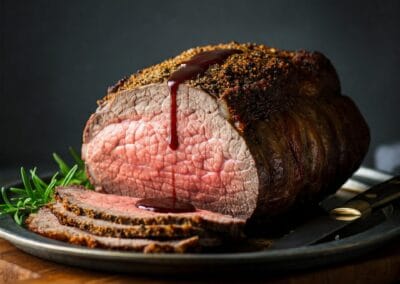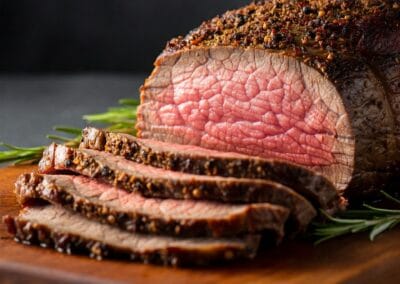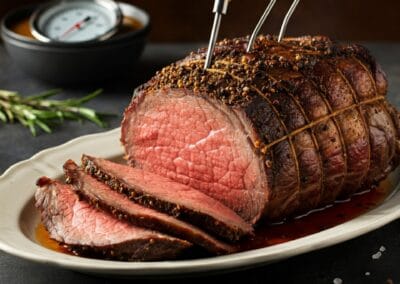Tender & Juicy Roast Beef
Roast beef is a true classic for a reason! It’s a dish that’s both elegant and comforting, perfect for special occasions and casual family dinners alike. Here’s why roast beef is such a great recipe choice:
- Flavorful and Tender: A perfectly roasted beef is a symphony of textures and tastes. The outer layer develops a beautiful crust, while the inside remains juicy and tender, offering a melt-in-your-mouth experience.
- Versatile: Roast beef can be the star of a holiday feast, a Sunday dinner centerpiece, or even sliced for sandwiches and salads. It’s a versatile dish that adapts to various occasions.
- Crowd-Pleaser: Roast beef is a crowd-pleaser that’s sure to satisfy everyone at the table, from young to old. It’s a dish that brings people together.
- Relatively Easy: While it might seem intimidating, roasting beef is actually quite straightforward. With a good recipe and a meat thermometer, you can achieve delicious results.
- Impressive Presentation: A beautifully roasted beef makes a stunning centerpiece for any meal. It’s a dish that’s as visually appealing as it is delicious.
- Leftovers: Roast beef leftovers are a gift that keeps on giving! Use them for sandwiches, salads, soups, or stir-fries for days after the initial meal.
If you’re looking for a recipe that’s both impressive and satisfying, roast beef is an excellent choice. It’s a culinary classic that’s sure to become a family favorite.
Tender and Juicy Roast Beef
Ingredients
- 4 lb Round Roast
 ¼ cup Extra Virgin Olive Oil
¼ cup Extra Virgin Olive Oil 3 Cloves Garlic minced
3 Cloves Garlic minced- 1 Tbsp rosemary chopped fresh
 1 Tbsp Thyme chopped fresh
1 Tbsp Thyme chopped fresh 4 tsp Kosher Salt
4 tsp Kosher Salt 1 tsp Ground Black Pepper
1 tsp Ground Black Pepper
Instructions
- For a more flavorful and evenly cooked roast, it's recommended to let it sit uncovered in the refrigerator for at least 2 hours, or even better, overnight. Place the roast on a wire rack set in a baking sheet to allow air to circulate around the meat. This will help to dry out the surface of the roast, which will result in a better crust when it's cooked.4 lb Round Roast
- Start by preheating your oven to 450 degrees Fahrenheit. In a small bowl, combine the olive oil, minced garlic, chopped rosemary, thyme, salt, and pepper. Mix well to combine. Once the roast has been chilled, remove it from the refrigerator. Rub the oil and herb mixture all over the roast, making sure to coat all sides evenly. This will create a flavorful crust and infuse the roast with delicious aromas.¼ cup Extra Virgin Olive Oil, 3 Cloves Garlic, 1 Tbsp rosemary, 1 Tbsp Thyme, 4 tsp Kosher Salt, 1 tsp Ground Black Pepper, 4 lb Round Roast
- Place the prepared roast in a roasting pan fitted with a roasting rack. This will allow air to circulate around the roast and promote even cooking. Place the roasting pan in the preheated oven and roast the beef at 450 degrees Fahrenheit for 15 minutes. This initial high heat will help to sear the outside of the roast, creating a flavorful crust. After 15 minutes, reduce the oven temperature to 325 degrees Fahrenheit and continue roasting the beef for 1 hour and 45 minutes for medium-rare. If you prefer your roast more well-done, you can roast it for longer, about 2 hours for medium-well. Use a meat thermometer to check the internal temperature of the roast to ensure it's cooked to your liking.4 lb Round Roast
- When the roast is cooked to your liking, remove it from the oven and transfer it to a carving board. Tent it loosely with aluminum foil to keep it warm. Let the roast rest for 15 to 30 minutes before carving. This resting period is important because it allows the juices to redistribute throughout the meat, resulting in a more tender and flavorful roast.4 lb Round Roast
Notes
- Types of Roasts: There are various cuts suitable for roasting, including rib roast, tenderloin, top round, and sirloin tip. Each has a different texture and flavor, so choose one that suits your preference and budget.
- Bone-In vs. Boneless: Bone-in roasts tend to have more flavor, while boneless roasts are easier to carve.
- Quality: Look for a roast with good marbling (flecks of fat throughout the meat), as this will help keep it moist during cooking.
- Chilling: Chilling the roast uncovered in the refrigerator for at least 2 hours, or even better, overnight, helps to dry out the surface, resulting in a better crust when roasted.
- Seasoning: Use a generous amount of salt and pepper, along with your favorite herbs and spices, to create a flavorful crust.
- Roasting Rack: Use a roasting rack to elevate the roast and allow for even cooking.
- Preheat Oven: Make sure your oven is properly preheated to the correct temperature.
- Searing: Starting the roast at a high temperature helps to sear the outside and create a flavorful crust.
- Reduce Heat: Lowering the oven temperature after searing allows the roast to cook more evenly and gently.
- Use a Thermometer: A meat thermometer is essential for determining doneness. Insert it into the thickest part of the roast, away from any bones.
- Resting: Allow the roast to rest for at least 15 minutes after cooking. This allows the juices to redistribute, resulting in a more tender and flavorful roast.
- Carving: Carve the roast against the grain for maximum tenderness.
- Gravy: Make a delicious gravy from the pan drippings to enhance the flavor.
- Sides: Serve with classic sides like roasted potatoes, Yorkshire pudding, and vegetables.
- Don't Overcrowd the Pan: Make sure the roast has enough space in the roasting pan for even cooking.
- Add Liquid: If you prefer a moister roast, you can add a bit of water or broth to the bottom of the roasting pan.
- Leftovers: Leftover roast beef can be used for sandwiches, salads, or stir-fries.
Nutrition
List of Ingredients:
For the Roast:
- 3-4 pound boneless beef roast (such as a top round, sirloin tip, or eye of round)
- 2 tablespoons olive oil
- 4 cloves garlic, minced
- 1 tablespoon chopped fresh rosemary
- 1 tablespoon chopped fresh thyme
- 2 teaspoons kosher salt
- 1 teaspoon black pepper
Optional for Gravy:
- 1 cup beef broth
- 2 tablespoons all-purpose flour
- 1 tablespoon butter
This is just a basic list, and you can always adjust the seasonings to your liking. Some people like to add other herbs like oregano or sage, or spices like paprika or onion powder. You can also use different types of oil, such as avocado oil or grapeseed oil.
If you plan to make a gravy, you’ll need the optional ingredients listed above. You can also add other ingredients to your gravy, such as red wine, mushrooms, or onions.
Image Gallery for Tender & Juicy Roast Beef
History of Tender & Juicy Roast Beef
While a specific recipe for “Tender and Juicy Roast Beef” might be a more modern creation, the history of roast beef itself is deeply rooted in culinary traditions, particularly those of England.
Here’s a glimpse into the historical journey of this classic dish:
Ancient Roots: The practice of roasting meat dates back to ancient times, when humans first discovered the method of cooking meat over an open fire. Early civilizations roasted whole animals for both sustenance and ceremonial purposes.
Medieval England: Roast beef gained prominence in medieval England, where it became a symbol of prosperity and hospitality. Large cuts of beef were roasted on spits over open fires, often served at feasts and celebrations.
A National Dish: By the 18th century, roast beef had become a national dish of England, celebrated in literature and song. The famous ballad “The Roast Beef of Old England” (1731) solidified its status as a culinary icon.
The Sunday Roast: Roast beef became a central component of the traditional Sunday Roast, a cherished British custom where families gather for a midday meal featuring roasted meat, potatoes, Yorkshire pudding, and other vegetables.
Modern Adaptations: While the methods of cooking roast beef have evolved with the advent of ovens and modern kitchen equipment, the essence of the dish remains the same. It’s a celebration of simple ingredients, time-honored techniques, and the comforting satisfaction of a perfectly cooked roast.
Key Influences:
- British Culinary Traditions: Roast beef is deeply ingrained in British culinary history, representing a cornerstone of English cuisine.
- Culinary Evolution: The methods of cooking roast beef have evolved over time, but the core principles of achieving tenderness and flavor remain central.
A Timeless Classic:
Tender and Juicy Roast Beef is a testament to the enduring appeal of this culinary classic. It’s a dish that continues to bring people together, offering a taste of tradition and a celebration of simple, satisfying flavors.
If you tried this recipe please share with us. Be as detailed as possible in your descriptions.










